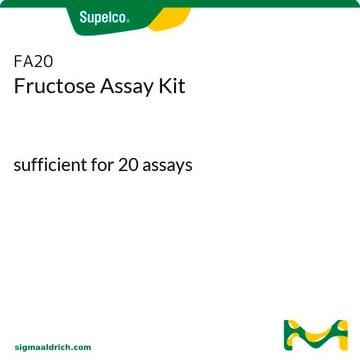MAK179
Oxalic Acid Colorimetric Assay Kit
Sufficient for 100 Colorimetric tests
Synonym(s):
Oxalate Assay Kit
Sign Into View Organizational & Contract Pricing
All Photos(2)
About This Item
Recommended Products
detection method
colorimetric
relevant disease(s)
genitourinary disorders
storage temp.
−20°C
General description
Oxalic acid (Oxalate) is a strong dicarboxylic acid that occurs in several plants and vegetables. In animals, it is either incorporated from the diet or produced during ascorbic acid and glyoxylic acid metabolism. Oxalic acid is not metabolized and is excreted in the urine. Hence, it can act as a marker for glyoxylic and ascorbic acid metabolism. Furthermore, oxalic acid has been studied as a pathogenic factor for Sclerotinia sclerotiorum that inhibits the oxidative burst response in host plants. It is also known to alleviate chilling injury in peach fruit. Elevated levels of oxalic acid (oxalate) have been associated with the formation of kidney stones. Hence, oxalate measurements can be used for the diagnosis and monitoring of renal stones.
Application
Oxalic acid colorimetric assay kit has been used in 24-hour urinary oxalate level (24HUOL) evaluation in an animal model.
Suitability
Suitable for the detection of oxalate (oxalic acid) in biological samples including animal and plant tissue.
Principle
The Oxalic Acid Assay Kit provides a simple and sensitive procedure for measuring oxalic acid in variety of samples including animal and plant tissue. In this assay, oxalic acid concentration is determined by a coupled enzyme reaction, which results in a colorimetric (450 nm) product, proportional to the oxalate present.
Kit Components Only
Product No.
Description
- Oxalate Assay Buffer
- Oxalate Developer Buffer
- Oxalate Converter
- Oxalate Enzyme Mix
- Oxalate Probe
- Oxalate Standard
Signal Word
Warning
Hazard Statements
Precautionary Statements
Hazard Classifications
Acute Tox. 4 Dermal - Acute Tox. 4 Oral
Storage Class Code
10 - Combustible liquids
Certificates of Analysis (COA)
Search for Certificates of Analysis (COA) by entering the products Lot/Batch Number. Lot and Batch Numbers can be found on a product’s label following the words ‘Lot’ or ‘Batch’.
Already Own This Product?
Find documentation for the products that you have recently purchased in the Document Library.
Characterizing the Association Between Toll-like Receptor Subtypes and Nephrolithiasis With Renal Inflammation in an Animal Model.
Olcucu M T, et al.
Urology, 111 , 238-e1-238-e1 (2018)
Oxalic Acid, a Pathogenicity Factor for Sclerotinia sclerotiorum, Suppresses the Oxidative Burst of the Host Plant.
Stephen G C, et al.
Plant Cell, 12(11), 2191?2200-2191?2200 (2000)
Strategies for preventing calcium oxalate stones
Vadim A F, et al.
CMAJ : Canadian Medical Association Journal = Journal de l'Association Medicale Canadienne, 174(10), 1407-1409 (2006)
Oxalic acid excretion after intravenous ascorbic acid administration
Line R, et al.
Metabolism, Clinical and Experimental, 58(2) , 263-269 (2009)
A structural investigation of the interaction of oxalic acid with Cu(110)
White T W, et al.
Surface Science, 668, 134-143 (2018)
Our team of scientists has experience in all areas of research including Life Science, Material Science, Chemical Synthesis, Chromatography, Analytical and many others.
Contact Technical Service



